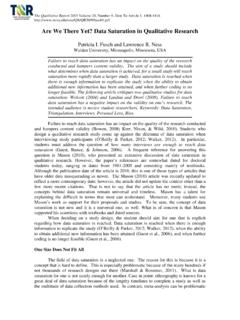Transcription of 72 Accommodations That Can Help Students with ADHD
1 72 Accommodations That Can Help Students with ADHD. Children and youth with attention deficit hyperactivity disorder (ADHD) often have serious problems in school. Inattention, impulsiveness, hyperactivity, disorganization, and other difficulties can lead to unfinished assignments, careless errors, and behavior which is disruptive to one's self and others. Through the implementation of relatively simple and straightforward Accommodations to the classroom environment or teaching style, teachers can adapt to the strengths and weaknesses of Students with ADHD. Small changes in how a teacher approaches the student with ADHD or in what the teacher expects can turn a losing year into a winning one for the child. Examples of Accommodations which teachers can make to adapt to the needs of Students with ADHD. 1. Seat student in quiet area 2. Seat student near good role model 3.
2 Seat student near teacher 4. Seat student near "study buddy". 5. Increase distance between desks 6. Allow extra time to complete assigned work 7. Shorten assignments or work periods to coincide with span of attention; use timer 8. Break long assignments into smaller parts so student can see end to work 9. Assist student in setting short term goals 10. Give assignments one at a time to avoid work overload 11. Require fewer correct responses for grade 12. Reduce amount of homework 13. Instruct student in self- monitoring of behavior using cueing ( hand raising, calling out). 14. Pair written instructions with oral instructions 15. Provide peer assistance in note taking 16. Give clear, concise instructions 17. Seek to involve student in lesson presentation 18. Cue student to stay on task ( private signal). 19. Ignore minor, inappropriate behavior 20. Increase immediacy of rewards and consequences PATH Project: 1-800-866-4726 PEN Project: 1-877-762-1435 TEAM Project: 1-877-832-8945.
3 21. Use time-out procedure for misbehavior 22. Supervise closely during transition times 23. Use "prudent" reprimands for misbehavior ( avoid lecturing or criticism). 24. Attend to positive behavior with compliments etc. 25. Set up behavior contract 26. Call on only when hand is raised in appropriate manner 27. Praise when hand raised to answer question 28. Allow student to stand at times while working 29. Provide opportunity for "seat breaks" ( run errands, etc.). 30. Provide short break between assignments 31. Remind student to check over work product if performance is rushed and careless 32. Give extra time to complete tasks (especially for Students with slow motor tempo). 33. Provide reassurance and encouragement 34. Frequently compliment positive behavior and work product 35. Speak softly in non-threatening manner if student shows nervousness 36. Review instructions when giving new assignments to make sure student comprehends directions 37.
4 Look for opportunities for student to display leadership role in class 38. Conference frequently with parents to learn about student's interests & achievements outside of school 39. Send positive notes home 40. Make time to talk alone with student 41. Encourage social interactions with classmates if student is withdrawn or excessively shy 42. Reinforce frequently when signs of frustration are noticed 43. Look for signs of stress build up and provide encouragement or reduced work load to alleviate pressure and avoid temper outburst 44. Spend more time talking to Students who seem pent up or display anger easily 45. Provide brief training in anger control: encourage student to walk away; use calming strategies; tell nearby adult if getting angry 46. If reading is weak: provide additional reading time; use "previewing" strategies; select text with less on a page.
5 Shorten amount of required reading; avoid oral reading 47. If oral expression is weak: accept all oral responses; substitute display for oral report; encourage student to tell about new ideas or experiences; pick topics easy for student to talk about 48. If written language is weak: accept non-written forms for reports ( displays, oral, projects); accept use of typewriter, word processor, tape recorder; do not assign large quantity of written work; test with multiple choice or fill-in questions 49. If math is weak: allow use of calculator; use graph paper to space numbers; provide additional math time;. provide immediate correctness feedback and instruction via modeling of the correct computational procedure PATH Project: 1-800-866-4726 PEN Project: 1-877-762-1435 TEAM Project: 1-877-832-8945. 50. Ask for parental help in encouraging organization 51. Provide organization rules 52.
6 Encourage student to have notebook with dividers and folders for work 53. Provide student with homework assignment book 54. Supervise writing down of homework assignments 55. Send daily/weekly progress reports home 56. Regularly check desk and notebook for neatness, encourage neatness rather than penalize sloppiness 57. Allow student to have extra set of books at home 58. Do not penalize for poor handwriting if visual-motor defects are present 59. Encourage learning of keyboarding skills 60. Allow student to tape record assignments or homework 61. Praise compliant and appropriate behavior 62. Provide immediate feedback 63. Use teacher attention to reinforce positive behaviors 64. Acknowledge positive behavior of nearby student 65. Implement classroom behavior management system 66. Monitor social interactions 67. Set up social behavior goals with student and implement a reward program 68.
7 Prompt appropriate social behavior either verbally or with private signal 69. Encourage cooperative learning tasks with other Students 70. Provide small group social skills training 71. Praise student frequently 72. Assign special responsibilities to student so others observe student in a positive light Revisions made from original article; original provided by Attention Deficit Disorder Resources. Article by Harvey C. parker , , a clinical psychologist and co-founder of CHADD (Children & Adults with ADD ). The contents of this publication were developed under a grant from the US Department of Education, H328M150022 (PATH), H328M150023. (PEN), & H328M150024 (TEAM). However, those contents do not necessarily represent the policy of the US Department of Education, and you should not assume endorsement by the Federal Government. PATH Project: 1-800-866-4726 PEN Project: 1-877-762-1435 TEAM Project: 1-877-832-8945.

